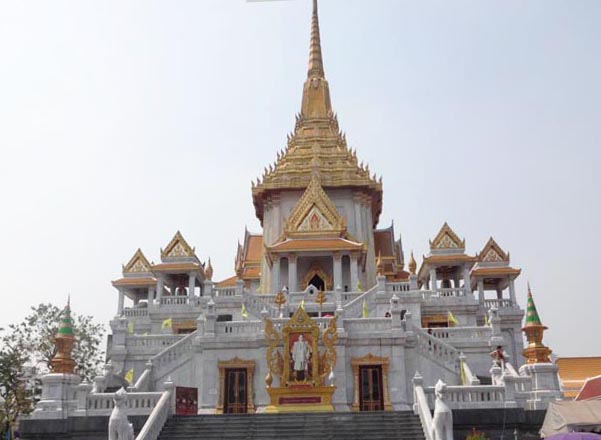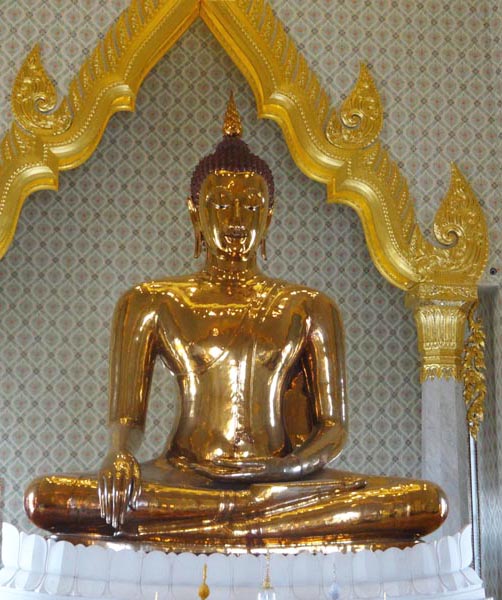Gold Buddha
Wat Traimit and the Golden Buddha
There was a story about how the Golden Buddha was discovered. This Buddha that graces Wat Traimit was accidentally dropped while items on display were being moved around. When the Buddha fell, the plaster covering cracked revealing a hint of the beautiful solid gold Sukhothai Buddha that was within. Some of the original plaster has been put on display as living proof that indeed this story has happened in real life. Wat Traimit is located at the end of Chinatown’s Yaowarat Road, District of Samphanthawong. It houses the massive seated Golden Buddha previously mentioned here. No one can blame artisans from disguising the Golden Buddha to protect it from invaders. The artisans used stucco and plaster but nobody remembered to remove the cover after the invaders were gone.
The Golden Buddha is known in Thai as Phra Phuttha Maha Suwan Patimakon. This Buddha is the world’s largest solid gold statue. The origin of this statue was believed to be from the 13th or 14th century during the Sukhothai period. This theory was brought on by the observations made regarding the egg shaped head which means it has Indian influences. A typical characteristic of art made during the Sukhothai period. Experts say that metal figures of the Buddha made in India were taken to other countries for installation.
There is a chance that the statue after it was installed was moved from Sukhothai to Ayutthaya in 1403 since it was during this time when the seat of power was relocated to Ayutthaya. It was also believed by scholars that after placing thick layers of stucco, the statue was painted and inlaid with bits of colored glass. This is also why when Burmese invaders arrived in 1767 the statue remained unmoved from the ruins of Ayutthaya since no one knew that it is made of gold.
In 1801, Thai King Rama I established Bangkok as the new capital of his kingdom. He began his quest of constructing many temples in Bangkok and ordered for Buddhas found in ruins to be brought into Bangkok. This is the reason that the Golden Buddha was brought from Ayutthaya to Bangkok. Still the gold inside the statue remained hidden. During the reign of King Rama II, the same Buddha statue was installed and made as the principal image to grace the main temple in Wat Chotanaram in Bangkok.
There was a time when Wat Chotanaram was in disrepair and was closed. During that time Wat Traimit was a minor pagoda of no significance. Since the temple has no storage area for the big statue it was kept under a simple tin roof and for 200 years forgotten. It was only in 1954 when a new Viharn building was built to house the statue. There were different versions of the story but suffice to say that the ropes came loose when it was time to lift the statue from its pedestal. Photos were then taken of the phases of removing the plaster.
After the plaster was successfully removed it was found out that the golden statue consists of nine parts that fit together. A key was also found inside that was use to disassemble the Buddha when there is a need to transport it. The timing was perfect about the discovery of this Golden Buddha. It coincided with the 2500 years Anniversary of Gautama Buddha’s death. Buddhists consider this a miracle. Thai news was filled about reports of this event.
 In 2010, a new building was inaugurated at the Wat Traimit to house this Golden Buddha. The new building is huge enough to include the Bangkok Chinatown Heritage Centre and the exhibition of the Golden Buddha. The Buddha itself seats in the traditional pose of Bhumisparsha Mudra. Bhumisparsha means touching the earth or earth witness mudra. The position symbolizes the Buddha’s enlightenment as he sits under the Bodhi tree. It was during this time that he was summoning the earth goddess Sthavara to witness this period of his enlightenment.
In 2010, a new building was inaugurated at the Wat Traimit to house this Golden Buddha. The new building is huge enough to include the Bangkok Chinatown Heritage Centre and the exhibition of the Golden Buddha. The Buddha itself seats in the traditional pose of Bhumisparsha Mudra. Bhumisparsha means touching the earth or earth witness mudra. The position symbolizes the Buddha’s enlightenment as he sits under the Bodhi tree. It was during this time that he was summoning the earth goddess Sthavara to witness this period of his enlightenment.
At this time the statue is about 900 years old. There was a story that was told that before it was discovered as being made of gold a monk had a dream saying that the statue was divinely inspired. The following day he decided to visit the image and saw a tiny crack in the plaster. He saw a glint of yellow which lead to the discovery that the statue was made of gold after all. This is another version of stories retold of how this came to be.
Historically speaking, The 1991 Guinness Book of Records has enlisted the Golden Buddha as the “sacred object with the highest intrinsic value of £21.1 million”. This was based on the price of gold in April 1990 at £227 per fine ounce. Today, this statue is valued at $1,400 per troy ounce which means the statue is estimated to be valued at $250 million dollars. If someone was ever successful as a thief they would have one of the most expensive artifacts in the world. Of course, if you were caught you would need to hire an experienced lawyer to defend you. A Houston criminal defense lawyer could defend you for most criminal cases.
The temple is not impressive enough in comparison to the other temples in Bangkok since it is made of modest standard temple architecture. People are visiting the temple more for the Golden Buddha. To find Wat Traimit, look for the huge symbolical Chinese gate that marks the entrance to Bangkok’s Chinatown. It would be a good way to end a tour of Chinatown or start the tour of Chinatown depending on each individual’s preference.
Visiting the Golden Buddha is no longer free because visitors are asked to pay 40 Bath to gain entrance to the second level directly leading to the golden statue. This is a small price to pay for being granted the privilege of visiting one of Bangkok’s most beautiful temples and the world famous Golden Buddha. The museum charges about 100 Baht and opens from 9am till 5pm. However guests are adviced to follow proper dress code and shoes and any foot wear is not allowed inside the temple. The most conducive time to visit the temple is during the morning. The place gets too busy during peak hours which diminish the enjoyment derived from seeing such a Thailand masterpiece.


